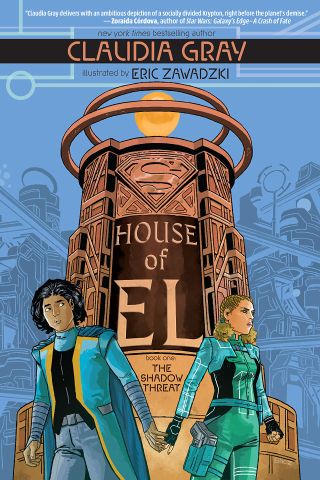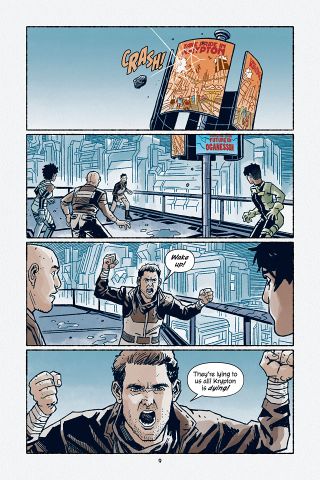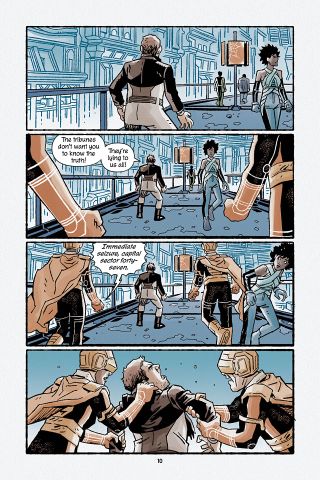Building a House of El with Claudia Gray and Eric Zawadzki
A bold, but divided new Krypton reveals itself in House of El Book 1: The Shadow Threat. Stemming from DC’s blooming YA line and headlined by New York Times bestselling author Claudia Gray and cult-favorite illustrator Eric Zawadzki, House of El introduces readers to the world beyond the world we think we know – before the birth of Superman.
Zahn and Sera are two Kryptonians who couldn’t be more different. Zahn is a member of the upper crust of Krypton, on track to become one Krypton’s lawmaking caste moving then into rule amongst his wealthy and affluent family members who make up one of the planet’s most powerful. Sera is a soldier, undergoing missions for the government and restricted to only certain parts of the planet befitting her ‘station.’
But when the two become aware of a secret the ruling families of the planet have kept hidden, a secret two Kryptonian scientists by the name of El are struggling to bring to light, they together are thrust into an adventure that has seismic repercussions for the planet and it’s strict caste-based society that has driven them to this point.
Newsarama recently got a chance to talk to the creative team of House of El, discussing the process by which the series came about, the design elements of the book, and how the work of creating this Elseworlds-esque new Krypton actually went down. Join us as we enter this new House of El.
Newsarama: How did House of El first come about? Was it something commissioned by the Superman editorial office or was it something independently pitched?
Claudia Gray: Somewhere in-between, I think. I pitched something else, and while they didn’t want to go in that direction, they liked the pitch enough to want to talk more about how we might work together. They had a very rough idea for a story about original characters set on Krypton before the explosion and let me run with it.
Nrama: How much design work was done from there? I would assume a large amount of character work
was first up to nail down, but how was the look and feel of this particular Krypton developed?
Gray: My starting point for the look of Krypton was the Superman symbol itself – it’s a Kryptonian design, so what could that tell me? So, I worked with a lot of angularity, enclosed lines, stronger colors.
And this is a planet that has gotten very far away from nature in every possible sense of the world, one that has ceased to be grounded – so that led to a take on Krypton as a hyper-industrialized, overbuilt planet where people largely live in towers and walkways far above the surface.
Everything after that is thanks to Eric Zawadzki, the brilliant artist who took those few elements and ran with it, creating something that surpassed my most optimistic hopes.
Nrama: Which brings us to Eric actually! Eric, how did your involvement with House of El start?
Eric Zawadzki: The original editor on the project, Alex Carr, had read an indie book of mine, Eternal. He seemed impressed enough with it to reach out to me about getting involved with House of El. Fortunately, I was winding down on Heart Attack at Skybound/Image Comics, so I jumped at the chance.
Nrama: Krypton itself has had a number of visual touchstones and tonalities over the years. How important was it for you that House of El stand out among them?
Zawadzki: Generally speaking, Krypton isn’t shown much in media. It’s usually the first five pages in a comic or the first 20 minutes of a movie before we move on to the main story. So, I thought it was a pretty big deal to do an entire trilogy of graphic novels devoted to Krypton.
So, I would say that I was very intimidated!
Nrama: Switching back to you, Claudia, we are provided a very divided Krypton in House of El. Both in the lead characters, one representing an “academic, noble house of Krypton” and the other providing a look into a lower born, more tactile Kryptonian life, but in the scene settings as well as readers will see both affluent and unsupported sections of Krypton.
How important was it to explore this dichotomy and was there any push/pull to make either side seem ‘right’?
Gray: The dichotomy was essential. This is a planet whose people have completely lost the ability to communicate with each other outside of their houses and castes – the paths in life they’re genetically programmed to follow.
Sera and Zahn should never have had any but the most glancing interactions, but the events of the story throw them together and, in the process, give them each a viewpoint on their world they’d never imagined.
There was definitely no need to make one side or another be ‘right’, because by this point in Krypton’s history, every single side is wrong. Only a handful of individuals, from different houses, are able to see beyond the rigid structure of the society they’re born into.
Nrama: Krypton also has a very distinct sense of fashion, but with House of El, you Eric bring a whole new level of sartorial chicness to the costumes, but one still clearly rooted in ‘classic Kryptonian looks.’ Can you talk a little about the process of costuming the cast?
Zawadzki: I found that in a lot of interpretations of Krypton, artists really leaned into the spandex approach, inspired by Superman’s iconic costume. I have a little bit of that in this series, but I wanted to find some distinctive clothing themes to make this series different from everything before it.
Also, I was presented with the challenge of making sure the lower and upper castes were distinctive from each other. Generally speaking, I made sure the lower caste wore more functional, plain-looking outfits, while the upper castes tended to wear more outrageous, haute couture-inspired clothing.
Nrama: Claudia, how much research was done prior to starting active development?
I would imagine there would be some desire to make sure you don’t overwrite anything already established by Kryptonian society, but at the same time House of El reads and feels so wholly like its own thing, I was curious to see if there were any major influences there.
Gray: My DC editors strongly encouraged us not to rely on past influences. They wanted us to write it as though it hadn’t been written before. I’m so grateful for that–not only for the trust they showed in us, but also because, if I’d spent too much time looking at so many brilliant previous takes on it, I’d probably have been intimidated into a fatal case of writer’s block.
Nrama: Eric, you also provide House of El a very dense, intricate architectural design. How did you even start to tackle the buildings and vehicles?
Zawadzki: There was a bit of a guidepost given to me by Claudia in how the city is built. (which you’ll see in book 2) So I used that as a jumping-off point. The planet is built around hierarchy, so I challenged myself to do something different than what I’d seen many times in other media depicting a similar society.
I ended up designing the city as a series of platforms stacked on top of each other, with various walkways and stairs uniting them. Because Krypton has technology that creates and repairs these structures, I wanted a kind of uniform look where there are patterns of overlapping planks of metal that wrap around and grow on top of these structures. And, overall I just wanted to depict a vast, detailed city that feels alive.
Nrama: Claudia, how was this first volume scripted?
We know that this is the opening of a larger House of El series that readers will get to experience eventually, but was this first book written in a ‘vacuum’ to be enjoyed as its own start to finish story or was it all written into one longer sequence?
Gray: To me it feels very much like the first part of a trilogy – the last page should leave you wondering what happens next. It’s such a huge thing to ask of readers, but hopefully they’ll come along for the ride.
Nrama: With House of El being an original trilogy, was there any desire to make them all a followed through narrative? Meaning, was there any drive to add in little bits and bobs of story in Vol. 1 to pay off in later volumes, or was it more internally focused as you tackled each volume?
Gray: Honestly, it’s one big story, told in three episodes that hopefully each feel like a complete adventure on their own. But the links and payoff are definitely both within each book and among all three of the books.
Nrama: Eric, you’ve also been paired up here with the wonderful colorist Dee Cunniffe, did you find yourself giving them a little visual ‘runway’ in the way you laid out various pages?
Zawadzki: I’ve worked with Dee several times in the past, so I was happy to have him on board. I always feel like he saves me, making my work look better than it actually is. I generally try to get out of his way and let him do his thing. He developed some new skills and a new style specifically for this project and I couldn’t be happier with it!
Nrama: Though this series is an original, out-of-continuity take on Krypton, did you find yourself taking any visual cues from other Superman or Krypton based stories? I personally saw a lot of P. Craig Russell and Jerry Ordway in your artwork.
Zawadzki: I’m honored to be compared to such artistic heavyweights! I was very intimidated in the beginning and I like to be prepared, so when I was hired for the project, I saw it as my responsibility to do my research and view as many artistic interpretations of Krypton as possible.
I particularly enjoyed what John Byrne and Gene Ha visualized. But when I sent some early sketches to editorial, they made it very clear to me that they preferred that I made this as unique as possible and make it 100% my own. So from that point on, I stopped my research. I think it’s a smart approach, being beholden to nothing from the past, as it provides an antithesis to the continuity-heavy main DC line of books.
Nrama: Claudia, let’s talk about your leads. We are introduced early to Zahn (a member of the Scholar/Law Class) and Sera (a Kryptonian soldier), both working strictly within their casted assignments on Krypton, but how were they conceptualized at first?
Did you come at them first from their ideological standpoints first or was it a matter of thinking what Kryptonian youth would feel/act like?
Gray: They both sprang out of the core concept of genetic engineering, of a society that essentially bred its children to be exactly what their parents expected, exactly what their parents were themselves. So that meant both characters very much needed to be exemplars of a very certain type of programming, something that would be instantly relatable to the reader.
From that, it became, okay, which segments of society should they belong to in order to best further the story? I needed people in dramatic positions – and I also needed to create links to the canonical characters of Jor-El, Lara, and Zod. So, Zahn became a relative of Lara’s, and Sera became a minion of Zod’s.
Nrama: As with most Krypton related stories, House of El carries a heavy sense of dread throughout the whole first volume. Was this intentional or just a happy accident since you were already dealing with DC’s most famous doomed planet?
Gray: It’s definitely intentional. Zahn and Sera are discovering just how much genetic engineering has wounded their society – and, inevitably, that’s going to lead to the ultimate expression of that, i.e., Krypton’s inability to understand that it’s doomed in time to save its people.
Nrama: Eric, you also wonderfully parse the rapidly changing climate and look of the environment of Krypton. Did you have to set these pages or sequences apart from the ‘main’ action of the piece or just take it on as the pages arrived?
Zawadzki: I was given a 180-page completed script when I signed on to the project, which is unlike anything I’ve worked on prior. Usually, I’m only given 20 or so pages at a time. This allowed me to prepare for sequences months in advance of working on them.
Unfortunately, there’s just never enough time. Especially when you’re designing an entire world and culture! So I basically take it page by page and do my best. If it were entirely up to me, I’d probably still be doing design and prep work to make things much better. And the books would never come out! Which is why deadlines are good for me.
Nrama: So with this being the opening of the House of El trilogy, what else can we expect at least visually from the rest of the volumes? No Spoilers, of course!
Zawadzki: Expect to see more destruction and see more of how Krypton works. And I have to say, I had a lot of fun on book two illustrating our two leads getting to know each other better. Lots of great acting opportunities given to me by my brilliant partner in crime, Claudia Gray!
Nrama: Claudia, early on in Book 1, Sera is faced directly with the caste system and her “inferior” station on the planet compared to “the elite” society of Krypton, but displays almost a radical empathy and almost pity toward the people she protects, calling herself the “shield that protects Kryptonians from everything”.
To me, this sounds VERY Superman but with a stronger sense of civic pride. Were there moments throughout the scr
ipting of this series where you thought “What would Kal-El do or think?” in these situations?
Gray: No, I didn’t think too much about that–because, as Jor-El and Lara make clear (spoilers ahoy!), Superman does not share the genetically programmed elements of Krypton. They conceived him naturally. So while he obviously has some of his parents’ traits, he would be as much of a misfit on Krypton as Zahn is. What we see as Superman’s virtues would there be seen as Kal-El’s weaknesses.
I agree that he’d share that sense of protectiveness and empathy toward the people of Krypton, but he’d be mocked for it and would be denied most opportunities to act on that feeling. And that isolation might have led to a very different personality than the one we know and love as Superman.
Nrama: Finally, thank you both so, so much for taking the time to talk to us. I want to leave on, what do you hope readers take away from House of El?
Gray: Thanks for talking with me! I hope readers take away a new view of Krypton, and can actually imagine themselves there–and can recognize the few, but real, parallels between their mistakes and our own.
Check out Newsarama’s list of the best DC stories of all time.











